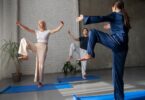Table of Contents
Introduction
Living with arthritis can be a constant battle against pain, stiffness, and limited mobility. However, a gentle, effective solution many people might not consider is chair yoga. This practice, which adapts traditional yoga poses to a seated position, offers numerous benefits for arthritis sufferers. From improving flexibility to reducing pain, chair yoga can significantly enhance the quality of life for arthritis patients. In this article, we’ll explore these benefits in detail, providing practical insights and tips for getting started.
Understanding Arthritis
What is Arthritis?
Arthritis is a condition that affects millions of people worldwide, causing joint pain, inflammation, and stiffness. There are over 100 types of arthritis, but the most common are osteoarthritis and rheumatoid arthritis. Osteoarthritis results from the wear and tear of cartilage, leading to joint damage. On the other hand, rheumatoid arthritis is an autoimmune disease where the body’s immune system attacks the joints.
Impact of Arthritis on Daily Life
Living with arthritis isn’t just about dealing with physical pain. It also impacts daily activities, challenging simple tasks like walking, bending, or even holding objects. The constant discomfort can lead to frustration, anxiety, and depression, affecting overall well-being. Therefore, finding effective ways to manage arthritis symptoms is crucial for maintaining a good quality of life.
Introduction to Chair Yoga
What is Chair Yoga?
Chair yoga is a form of yoga that adapts traditional poses to be performed while seated in a chair or using the chair for support. This makes it accessible to people with mobility issues, including those with arthritis. Unlike regular yoga, chair yoga doesn’t require getting down on the floor, which can be difficult for those with joint pain.
History and Development of Chair Yoga
Chair yoga has evolved as a modified form of yoga to make it more inclusive. It was developed by yoga instructors who recognized the need for a gentler, more accessible practice. Chair yoga retains the core principles of yoga, such as breathing techniques and mindfulness, while making the poses adaptable for all levels of ability.
Benefits of Chair Yoga for Arthritis
Physical Benefits
One of the primary benefits of chair yoga for arthritis is improved flexibility. Regular practice helps increase the range of motion in the joints, making daily activities easier and less painful. Additionally, chair yoga enhances muscle strength, providing better support for the joints and reducing strain.
Another significant benefit is pain reduction. Gentle stretches and movements in chair yoga help alleviate stiffness and improve circulation, which can reduce joint pain. Studies have shown that people who practice chair yoga regularly experience less pain and greater mobility.
Chair yoga also helps with balance and stability. Since arthritis can affect coordination, chair yoga poses that focus on balance can help prevent falls and improve overall stability.
Mental and Emotional Benefits
Arthritis doesn’t just take a toll on the body; it also affects mental health. Chair yoga incorporates breathing exercises and mindfulness techniques that can reduce stress and anxiety. Practicing yoga helps calm the mind, leading to a more relaxed and positive outlook.
Moreover, chair yoga has been shown to improve mood and overall emotional well-being. The combination of physical activity, relaxation, and social interaction (if practiced in a group) can boost mental health and combat feelings of depression.
Another benefit of chair yoga is better sleep. Many people with arthritis struggle with sleep due to pain and discomfort. Chair yoga’s calming effects can improve sleep quality, making it easier to cope with daily challenges.
Research and Studies
Scientific research supports the benefits of chair yoga for arthritis. According to a study published in the Journal of Rheumatology, participants who practiced chair yoga reported significant improvements in pain, physical function, and mental health compared to those who did not. Another study in the Journal of Geriatric Physical Therapy found that chair yoga can reduce pain and depression in older adults with osteoarthritis.
Real-life testimonials also highlight the positive impact of chair yoga. Many arthritis patients have shared their success stories, noting improvements in pain management, mobility, and overall quality of life.
Related Article: Chair Yoga Safety Tips for Seniors: How to Avoid Injuries
Practicing Chair Yoga
Getting Started with Chair Yoga
Starting chair yoga can be a refreshing and gentle way to manage arthritis symptoms. Here are some tips to help you begin:
Find a Comfortable Chair
Choose a sturdy chair without wheels. Ensure it’s at a height where your feet can rest flat on the ground and your knees are at a right angle. This stability helps you feel secure during the exercises.
Wear Comfortable Clothing
Opt for loose, comfortable clothing that allows for a full range of motion. Avoid anything too tight or restrictive.
Set Up Your Space
Find a quiet, well-lit space with enough room to freely move your arms and legs. Keep water nearby to stay hydrated.
Warm Up
Before diving into chair yoga, start with a gentle warm-up to loosen your muscles. Simple neck and shoulder rolls can help prepare your body for the session.
Basic Chair Yoga Poses for Arthritis
Chair yoga includes a variety of poses that can be modified to fit your needs. Here are some basic poses that are particularly beneficial for arthritis:
Seated Mountain Pose (Tadasana)
- Sit with your feet flat on the floor, hip-width apart.
- Place your hands on your thighs, palms down.
- Sit up straight, lengthening your spine, and look straight ahead.
- Take deep breaths in and out, maintaining this posture for a few breaths.
Seated Cat-Cow Stretch (Marjaryasana-Bitilasana)
- Sit on the edge of your chair with your feet flat on the floor.
- Place your hands on your knees.
- Inhale and arch your back, lifting your chest and looking up (Cow Pose).
- Exhale around your back, tucking your chin towards your chest (Cat Pose).
- Repeat for several breaths, moving smoothly between the two poses.
Seated Forward Bend (Uttanasana)
- Sit on the edge of your chair with your feet together.
- Inhale, lengthen your spine and reach your arms up.
- Exhale, fold forward, bringing your hands towards your feet.
- Let your head hang heavy, and hold for a few breaths before slowly coming back up.
Seated Spinal Twist (Ardha Matsyendrasana)
- Sit sideways on your chair with your feet flat on the floor.
- Hold the back of the chair with both hands.
- Inhale, lengthen your spine.
- Exhale, twist your torso towards the back of the chair, keeping your hips facing forward.
- Hold for a few breaths, then switch sides.
Seated Pigeon Pose (Eka Pada Rajakapotasana)
- Sit with your feet flat on the floor.
- Place your right ankle on your left knee, forming a “4” shape.
- Flex your right foot to protect your knee.
- Sit up straight, and if comfortable, lean forward to deepen the stretch.
- Hold for a few breaths, then switch legs.
Chair Yoga Routine for Arthritis Relief
Here’s a simple chair yoga routine that can help alleviate arthritis symptoms. Perform this routine daily or a few times a week for best results:
- Warm-Up
- Neck rolls
- Shoulder rolls
- Main Exercises
- Seated Mountain Pose (5 breaths)
- Seated Cat-Cow Stretch (5 rounds)
- Seated Forward Bend (5 breaths)
- Seated Spinal Twist (5 breaths on each side)
- Seated Pigeon Pose (5 breaths each leg)
- Cool Down
- Seated Meditation: Sit comfortably, close your eyes, and focus on your breath for a few minutes.
Safety Tips and Precautions
Safety Considerations
Practicing chair yoga can be incredibly beneficial for arthritis, but it’s important to keep safety in mind. Here are some key safety tips:
Consult Your Doctor
Before starting any new exercise regimen, including chair yoga, it’s essential to talk to your healthcare provider. They can offer personalized advice based on your specific condition and medical history.
Listen to Your Body
Pay attention to how your body feels during each pose. If you experience any sharp pain or discomfort, stop immediately. It’s normal to feel some mild stretching, but you should never push yourself to the point of pain.
Move Slowly and Gently
Arthritis can make your joints more sensitive, so it’s crucial to move slowly and gently. Avoid quick, jerky movements, and focus on smooth, controlled motions.
Stay Hydrated
Keeping yourself hydrated is important, especially when engaging in physical activity. Drink water before, during, and after your chair yoga session to stay well-hydrated.
Modifications and Adaptations
To make chair yoga more accessible, especially if you have severe arthritis or limited mobility, consider these modifications:
Use Props
Props like yoga blocks, straps, and cushions can help make poses more comfortable. For instance, placing a cushion on the chair can provide extra support for your back and hips.
Modify Poses
Don’t hesitate to modify poses to suit your comfort level. For example, if a full forward bend is too challenging, you can place your hands on your thighs instead of reaching for your feet.
Take Breaks
If you feel tired or overwhelmed, take a break. It’s perfectly okay to rest for a few minutes before continuing with your practice.
Adapt Your Routine
Tailor your chair yoga routine to fit your needs. If certain poses are too difficult, skip them and focus on the ones that you find beneficial and comfortable.
Be Mindful of Your Environment
Creating a safe environment is crucial for a successful chair yoga practice:
Choose a Stable Chair
Make sure your chair is sturdy and doesn’t wobble. A chair with armrests can provide additional support if needed.
Clear the Area
Remove any obstacles around your chair to prevent tripping or bumping into things. Ensure you have enough space to stretch your arms and legs freely.
Wear Non-Slip Shoes or Go Barefoot
Wearing non-slip shoes or practicing barefoot can provide a better grip and prevent slipping during poses.
Avoid Slippery Floors
Practice on a stable, non-slip surface. If you’re on a smooth floor, consider placing a yoga mat under your chair for added stability.
By following these safety tips and precautions, you can confidently practice chair yoga and enjoy its many benefits without putting unnecessary strain on your joints.
Conclusion
Incorporating chair yoga into your daily routine can be a gentle yet effective way to manage arthritis symptoms. The benefits are extensive, from improving flexibility and strength to reducing pain and stress. This practice is accessible and can be tailored to your needs, making it an excellent option for those with limited mobility or joint pain.
Starting with chair yoga is simple. Begin by finding a comfortable, sturdy chair and setting up a safe practice space. Follow the basic poses and routines, paying attention to your body and modifying as necessary. Remember, consistency is key—regular practice will yield the best results.
Additionally, always prioritize safety by consulting with your healthcare provider before beginning, moving slowly, and listening to your body. Use props and adjust poses to suit your comfort level, and don’t hesitate to take breaks when needed.
Practicing chair yoga can relieve arthritis symptoms and improve your overall quality of life. It’s a journey towards better mobility, reduced pain, and enhanced mental well-being. Give it a try and see the positive changes it can bring to your life.
For more information on the benefits of chair yoga for arthritis and additional resources, check out Johns Hopkins Arthritis Center, and YogaUOnline.
Related Article: 10 Benefits of Chair Yoga for Seniors






